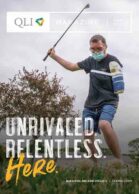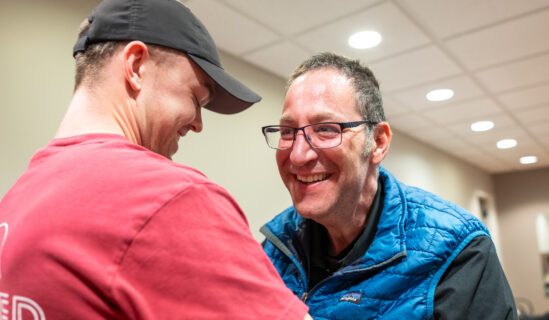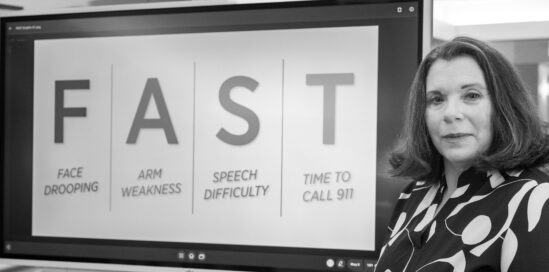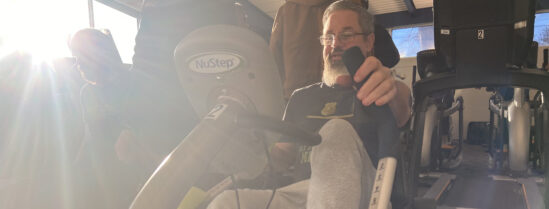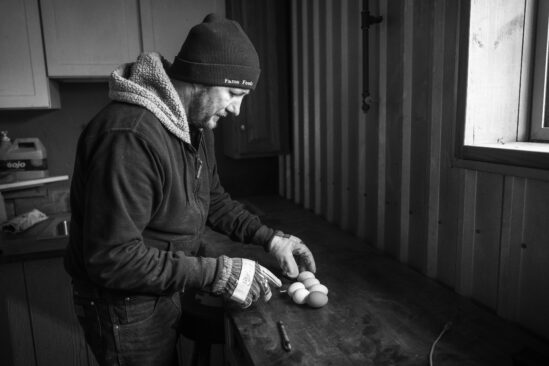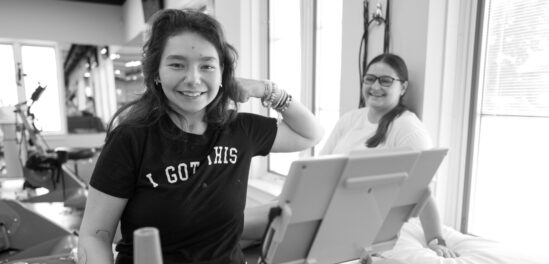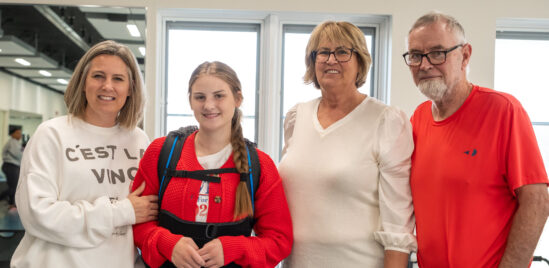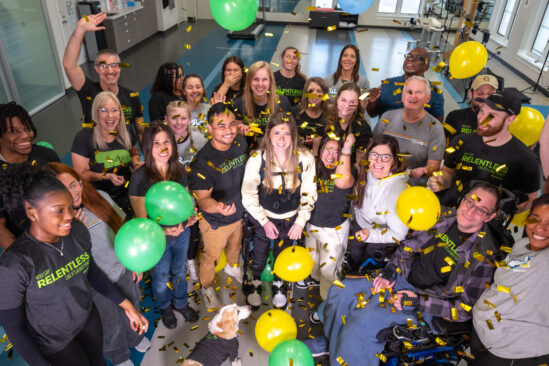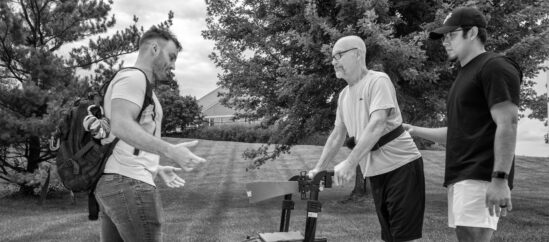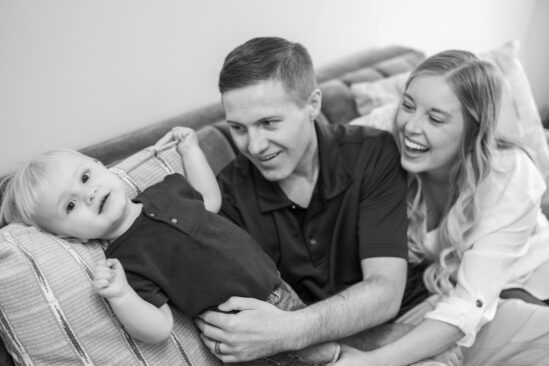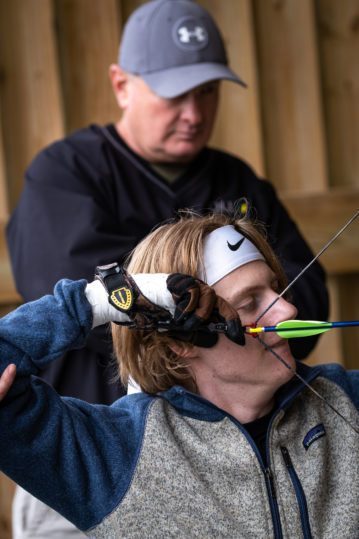 The arrow strikes the coyote decoy above the kneebend of its hind leg. Barely a hit, the point only sinks in for the firmness of the target’s foam. Given a softer target, the arrow would’ve passed right through. A faster one, missed altogether.
The arrow strikes the coyote decoy above the kneebend of its hind leg. Barely a hit, the point only sinks in for the firmness of the target’s foam. Given a softer target, the arrow would’ve passed right through. A faster one, missed altogether.
“I’m fighting spasms,” says 20-year-old Marty Ewing, seated in a manual wheelchair, holding a compound bow across his lap. The muscles affected by his spinal cord injury sometimes contract beyond control. They skew his balance, scatter his focus. He waits until the tremors subside.
Marty, surrounded at the moment by his father, Carl Ewing, and Jack Mahaffey and Seth Wannamaker—QLI’s adaptive sports specialist and spinal cord injury mentor, respectively—is just one week away from a triathlon event called The Challenge. It’s a specialized event hosted by QLI, hand-crafted just for Marty to leverage his athletic interests and target his physical attributes.
Archery, the first of The Challenge’s events, presents a test of precision and abdominal control. The second event, a mile pushed around QLI’s lake in a rugby wheelchair, demands tremendous cardiovascular endurance and upper-body strength. A pair of rugby drills conclude The Challenge, incorporating dynamic, complex movement at a point of physical exhaustion.
Today he hones his aim with the bow, firing downrange at a trio of decoys. A mechanical release connects his hand at the wrist to the bowstring, allowing him to loose an arrow with a simple triggerpull. But a new wrinkle adds unexpected difficulty.
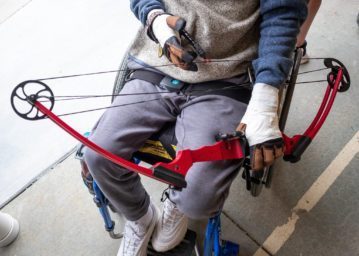 Both of Marty’s hands are wrapped in tape. When he takes on The Challenge in earnest, he plans to hit his archery targets then transfer from his own wheelchair into the rugby chair. The tape provides him extra grip on the rugby chair’s streamlined wheelpanels, and the process of securing the tape around his gloved hands requires too much time to be done between challenges.
Both of Marty’s hands are wrapped in tape. When he takes on The Challenge in earnest, he plans to hit his archery targets then transfer from his own wheelchair into the rugby chair. The tape provides him extra grip on the rugby chair’s streamlined wheelpanels, and the process of securing the tape around his gloved hands requires too much time to be done between challenges.
So he must hit the targets with his hands under multiple layers. It proves harder than expected.
“I want to see your core up. Sit up straight, son,” Carl says.
“Keep that string to your cheek,” Seth says. “In my opinion, the shot doesn’t count if you can’t fire it right.”
Marty clips another arrow onto the drawstring. He nestles back into the seat and exaggerates a backward lean to counter the forward weight of the bow. Only in recent weeks have the muscles that keep him upright begun to strengthen.
He fires. This arrow, too, zips off-target.
Jack Mahaffey steps into Marty’s line of sight. By this point they’ve adjusted and readjusted the length of the mechanical release. They’ve suggested solutions for him to manage his body position. It’s been an hour. The coyote is the last remaining target, centered down the length of the range with only the arrowshaft in the meat of its leg as a sort of mocking totem.
“Alright, Marty,” Jack says. “Maybe it’s time to pack it in. We can try again next week.” Jack’s face lights up, smiling—it’s a knowing poke.
Marty responds immediately: “Jack, get out of the way. I’m going to hit this damn target.”
The group laughs. Jack slaps Marty on the shoulder and moves behind the firing zone.
With a sharp breath through the nose, one he buries deep in his lungs, Marty’s demeanor changes. His face contorts into something almost like anger. Never blinking. The compound bow comes up, an arrow on the drawstring. For a beat it swings with unsteady movement. Then, stillness. No wind. No birds. Not even the sound of traffic far off. Only a quiet so heavy a person might think the world had stopped.
He fires. There’s no time between the release and the impact’s muted bumpf to predict the arrow’s trajectory.
This one is true. A bullseye. A lethal vector into the coyote’s heart.
“Look at Katniss freakin’ Everdeen over here!” Marty shouts amidst an uproar from his trio of witnesses. The group bursts into laughter and Jack slaps Marty’s hand with an audible high five. The victory is only a start. But as far as starts go, it’s a good one. And in that moment the four of them celebrate as if they’d all had a hand on the drawstring.
This challenge—indeed, The Challenge—is part of Marty’s ongoing rehabilitation. One chapter in a months-long story of recovery after a near-fatal gunshot in March ripped through his throat and struck his spinal cord.
For Marty, this recovery goes beyond the physical. Growth takes on many forms.
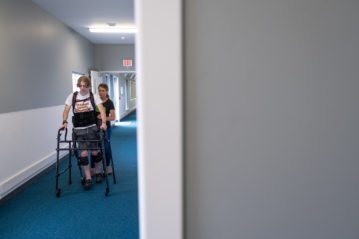
In some ways, the most important of those forms are emotional.
“It’s easy to look at yourself as a ‘half-self’ after an injury like this,” Marty says. “I always wanted to be a leader growing up. Any kind of leader. The best leader I could be, no matter what I’m doing. This kind of injury lowers your confidence. Makes you feel small.”
He had already been that kind of leader in life, as a standout pitcher for the Indiana University South Bend Titans. He knew what it took to be the tip of the spear, to be the guy everyone else depended on, to be the lynchpin of a team with championship hopes.
This was different. This was the other side of the equation. This was looking at a lifetime of dependence.
“All my life I’ve hated being still, hated not doing anything. Not having control is devastating.”
Marty calls his time in an intensive care unit a “big stare.” A haze, a void. Nerve pain made him sensitive to the touch. He lost most function below his arms, including the hands with which he’d perfected the craft of throwing a baseball. Within weeks he’d dropped 50 pounds of body mass. The prospect of rehabilitation loomed like a fog, the path to recovery not so much impossible as it was imperceptible.
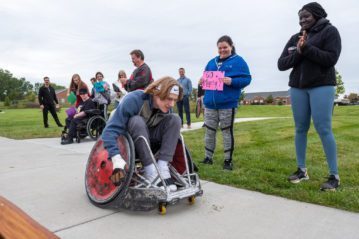 And yet, support rained in from all sides.
And yet, support rained in from all sides.
From his mother and father, tireless resources of humor, of inspiration, of motivation. From his hometown community and the players on his baseball team, who raised funds on his behalf and played the rest of the season in his honor. From the trauma surgeons who urged him to, above all else, take one day at a time, and the doctors at Chicago’s Shirley Ryan AbilityLab, who reassured Marty that his injury—an incomplete spinal cord injury—wasn’t the life sentence he imagined.
Early progress reaffirmed his potential. In 56 days at the AbilityLab, he progressed from having almost no movement whatsoever to, by discharge, having the strength to push a manual wheelchair 1500 feet—over a quarter of a mile.
He arrived at QLI still dependent on others. With his arms and hands, not to mention much of his core, still weakened by injury, Marty struggled to manage basic, fundamental skills. Feeding himself, putting on t-shirts, taking care of bathroom needs, navigating between buildings in a wide campus setting rather than assisted escort from hospital bed to therapy room and back again.
These tasks marked all the ways in which QLI veered from his previous rehabilitation experience. Instead of providing preemptive solutions to his needs, QLI’s clinicians asked Marty to create his own. The training aimed to maximize his abilities, not substitute for them.
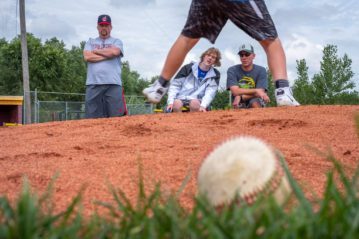 “It was scary,” Marty says. “Here I am. I’ve got this eight-hour, ten-hour therapy schedule every day. I’ve got things to do every day, and I’m the one who needs to figure this out. It wasn’t until QLI started training me to handle everyday life that I started seeing things, things like my hands coming back.”
“It was scary,” Marty says. “Here I am. I’ve got this eight-hour, ten-hour therapy schedule every day. I’ve got things to do every day, and I’m the one who needs to figure this out. It wasn’t until QLI started training me to handle everyday life that I started seeing things, things like my hands coming back.”
He talks about playing baseball with an obsession for detail. A thrown pitch is a fragile thing, he explains, transformed in obvious ways by even the smallest of inconsistencies. The placement of your fingertips, the tightness of your wrist, the followthrough after the ball leaves your hand. Mechanics dictate results.
This obsessive bent manifests in the effort he pours toward rehabilitation. Whether watching the electrodes of a functional electrical stimulation bike trigger his leg muscles, or fixating on the response his body gives to a set of trunk rotations, Marty keeps himself vigilant in the pursuit of fine improvements. Subtle changes give voice to resounding milestones.
“Even today,” he says during the interview for this story, “I felt my glutes activate for the first time. Things are coming back.”
His improvements have become almost too numerous to count. Working with QLI therapists, his hands have regained much of their previous dexterity. And after hundreds of hours participating in QLI’s intensive physical therapy and conditioning inside QLI’s weight room, his upper body surges with renewed strength.
Ultimately, much of his success results from mindset. From the way he’s turned the hardship of loss into an attitude of perseverance.
Marty has a way of making each therapy session an impromptu comedy show. He puts on voices and runs through bits with his trainers. Old-timey gangster affectations or an exaggerated Bostonian accent. But amidst the joking, Marty employs a phrase that has since caught on with his rehab team—“full send or no send.” He’ll shout the motto in its entirety before a new challenge, or sometimes just “Full Send!” before attempting a task just outside his comfort zone. Occasionally his therapists volley a “Full Send!” in return.
For years, it was just a fun thing to say around friends. To do something “full send” is to leave nothing on the table, to go all out, to ignore the consequences. But, like everything else in this world after injury, the expression is different now. Extra meaning hangs over the phrase like some kind of anthem.
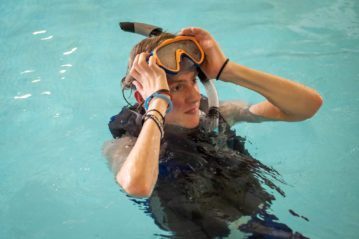 “You either go full send or no send,” Marty says. “There’s no half send in life. If you’re not going to give something you care about your full attention, then you shouldn’t do it at all.”
“You either go full send or no send,” Marty says. “There’s no half send in life. If you’re not going to give something you care about your full attention, then you shouldn’t do it at all.”
It’s more than a catchphrase. It’s an embodiment of the way Marty steels himself against the unknown. His first time in a swimming pool after injury, for instance, wasn’t characterized by a dependence on therapist assistance. Marty took things into his own hands. Knowingly buoyed by a life-jacket, he splashed face-first into the water without question. Within seconds, he’d devised a way to breaststroke from one end of the 50-foot pool to the other, despite having no help from his legs. Just a life-jacket and a snorkeling mask.
Full send.
Months into his rehabilitation at QLI, Marty doesn’t ignore any of the adversity he continues to face. Certainly not the fear or the newfound insecurity he feels from the seat of his wheelchair. But it’s not the kind of adversity that could ever slow him down. Instead, his is an engine self-sustained on forward momentum. He labors ahead, choosing to push himself when others might ask “why me?”
Fear is okay. Doubt is natural. But self-pity? Unacceptable. A dead end. And this life is too short for dead ends.
Each day demands ferocity, intensity, endurance. And in the time since being struck by an errant bullet, Marty has only become an example of triumph.
He says November is the month he’ll make his voyage back to Indiana. The first time home in over seven months. It will be a different Marty returning. But not a Marty less capable.
He’s come far enough to see an everyday life that looks familiar—living in an apartment with relative independence. Driving again, too, thanks to a simple modification that allows him to operate motor vehicles with hand controls.
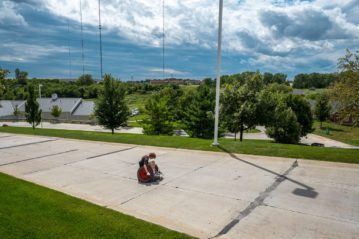 “Might be an actual road trip by the time I’m done here,” he jokes, an oblique reference to the notion that he’s close to purchasing a vehicle of his own, thanks to the oversight and guidance of QLI’s adaptive driving specialist. He doesn’t count the 500-mile commute outside the realm of possibility.
“Might be an actual road trip by the time I’m done here,” he jokes, an oblique reference to the notion that he’s close to purchasing a vehicle of his own, thanks to the oversight and guidance of QLI’s adaptive driving specialist. He doesn’t count the 500-mile commute outside the realm of possibility.
He’s even found renewed purpose along this journey. When Marty returns to school, he’ll be returning with the intent to pursue a medical degree, eventually specializing in spinal cord injury research. Leaders inspire through empathy, by touching a note of kindred experience and using that shared ground to guide others beyond hardship. In this way, Marty can be the leader he’s always been, focusing his energy on making those around him better.
In truth, that quality of leadership was never in doubt.
When The Challenge rolls around, one week after his first duel with the coyote, Marty finds himself far from alone. More than forty people—including his grandparents, fresh off the seven-hour drive from Indiana—await his performance. QLI staff are here, but fellow rehabilitation clients watch as well, people who’ve been inspired by the young man’s fight, his effort, his knock-down, drag-out desire to succeed.
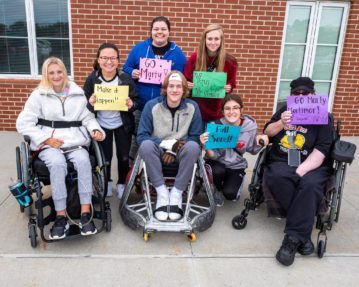 Many wave big, hand-drawn signs. A few of the signs read “Full Send” and “Full Send or No Send!”
Many wave big, hand-drawn signs. A few of the signs read “Full Send” and “Full Send or No Send!”
Marty positions his wheelchair at the firing line taped onto the concrete flooring of the outdoor firing range. The crowd gathers behind him in a loose half-circle. A familiar sight awaits Marty at the far end—three decoy targets. One turkey, one whitetail deer, and the coyote.
His hands gloved and taped over, an arrow on his bowstring, Marty waits as Jack Mahaffey explains the rules of The Challenge to the audience. As planned, the event is broken into thirds. But the archery event is the standing question mark. Everything else—the mile and the rugby drills that follow—seems within control.
Carl stands within an arm’s reach of his son. He holds a phone in his hand. They have agreed to time The Challenge in its entirety, hopeful Marty can complete all three events—travel time between event locations included—in under 30 minutes.
The crowd hushes before Jack signals Marty to begin. Jack gives Marty the go-ahead. Carl’s timer starts counting.
Marty brings the armed bow up to eye level with ease. He aims for the turkey decoy first. The arrow streaks away from the bow, planting without wasted movement into the turkey’s center mass. Moments later, the deer receives a matching ornament, board-straight between the ribs.
Around Marty, the crowd is raucous, only bottling their anticipation after he clips the third arrow onto the drawstring.
It’s almost jarring, watching his expressions in this moment, comparing them to his struggles against the coyote a week earlier. There’s nothing here of the anger or frustration he showed before. Nothing that speaks to anything but an intense calm. An unmovable focus. You might think he’d forgotten about last week altogether. That may very well be the truth.
Marty buries the arrow into the coyote on his first shot. Right in the heart, the same place he’d hit the week before.
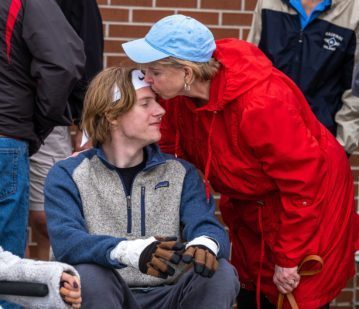 Just over twenty minutes later, Marty officially conquers The Challenge. The total time elapsed: 27 minutes, 15 seconds. His grandmother plants a kiss on his forehead. She tells him, “You make us so proud.” There is nothing but joy to be shared, and Marty—after breathlessly chugging a 16-ounce bottle of water so fast it crumples—thanks each person in attendance individually.
Just over twenty minutes later, Marty officially conquers The Challenge. The total time elapsed: 27 minutes, 15 seconds. His grandmother plants a kiss on his forehead. She tells him, “You make us so proud.” There is nothing but joy to be shared, and Marty—after breathlessly chugging a 16-ounce bottle of water so fast it crumples—thanks each person in attendance individually.
The whole experience washes over in a wave of introspection.
“This has been the ultimate learning experience,” Marty says. “How do you continue to love the life you have while still working on the skills you need? It took me a long time to realize that life was going to be okay. But the truth is, I’m still me. The legs don’t make the man.”
Part of what makes The Challenge special is the sheer physical exertion of it. It combines in grand scale many of the abilities Marty has worked to regain, and it speaks to the incredible progress he’s made in seven months.
But The Challenge also puts Marty’s most important trait front and center: his talent for responding when the response matters. Today’s effort shows that, surrounded by countless friends and family members and raving fans, he’s grown far beyond the young man paralyzed in a hospital bed. And that he’ll face any challenge the same way he faced The Challenge:
Full send.



